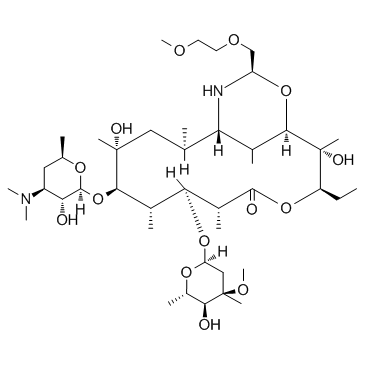Dirithromycin: a new macrolide.
S M Wintermeyer, S M Abdel-Rahman, M C Nahata
文献索引:Ann. Pharmacother. 30(10) , 1141-9, (1996)
全文:HTML全文
摘要
To review the clinical microbiology and therapeutic use of dirithromycin, emphasizing comparative data between dirithromycin and the standard macrolide erythromycin, as well as clarithromycin and azithromycin.A MEDLINE search of English-language literature during the years 1966-1996, and an extensive review of journals were conducted to prepare this article.The data on pharmacokinetics, adverse effects, and drug interactions were obtained from open and controlled studies. Controlled single- or double-blind studies were evaluated to assess the efficacy of dirithromycin in the treatment of various upper and lower respiratory tract infections, as well as skin and soft tissue infections.The spectrum of activity of dirithromycin is similar to that of erythromycin, clarithromycin, or azithromycin, with some notable exceptions. Dirithromycin was more active in vitro against Campylobacter jejuni and Borrelia burgdorferi than was erythromycin or clarithromycin, but in general demonstrated less activity than erythromycin, clarithromycin, or azithromycin against a majority of microorganisms. The pharmacokinetic profile of dirithromycin offers the advantages of once-daily dosing and high and prolonged tissue concentrations; dosing adjustments are not needed in the elderly or in patients with renal or mild hepatic impairment. Clinical efficacy and bacteriologic eradication rates with dirithromycin and erythromycin are comparable for the treatment of respiratory and skin and soft tissue infections due to susceptible pathogens. Dirithromycin appears to have adverse effect profiles similar to those of the other macrolides, with reported problems most often related to the gastrointestinal tract. Dirithromycin does not seem to cause clinically important interactions with drugs such as theophylline, oral contraceptives, cyclosporine, or terfenadine.Dirithromycin offers some attractive pharmacokinetic properties. The long elimination half-life of dirithromycin allows once-daily dosing and higher and more prolonged tissue concentrations than are achievable with erythromycin. The spectrum of activity, adverse effect profile, clinical efficacy, and bacteriologic eradication rate of dirithromycin may be similar to those of erythromycin. No significant drug interactions with dirithromycin have been reported. Based on available data, dirithromycin may not offer any unique clinical advantage over clarithromycin or azithromycin. Future clinical trials may reveal a special role for dirithromycin in patient care.
相关化合物
| 结构式 | 名称/CAS号 | 分子式 | 全部文献 |
|---|---|---|---|
 |
地红霉素
CAS:62013-04-1 |
C42H78N2O14 |
|
The new macrolide antibiotics: azithromycin, clarithromycin,...
1992-01-01 [Ann. Pharmacother. 26(1) , 46-55, (1992)] |
|
Pharmacokinetics of dirithromycin.
1993-03-01 [J. Antimicrob. Chemother. 31 Suppl C , 65-75, (1993)] |
|
Modulation of human polymorphonuclear neutrophil function by...
1993-03-01 [J. Antimicrob. Chemother. 31 Suppl C , 51-64, (1993)] |
|
Macrolide - induced clinically relevant drug interactions wi...
2000-10-01 [.PubMed ID] |
|
Dirithromycin. A review of its antimicrobial activity, pharm...
1994-10-01 [Drugs 48(4) , 599-616, (1994)] |